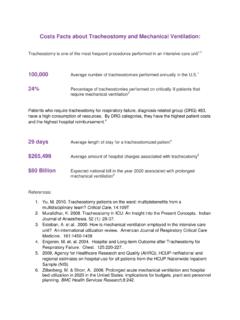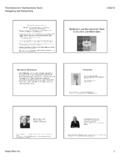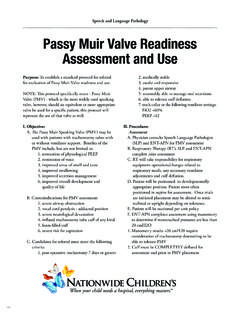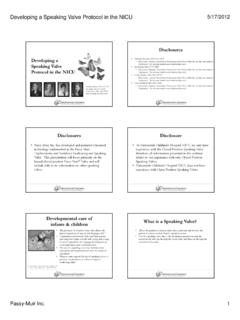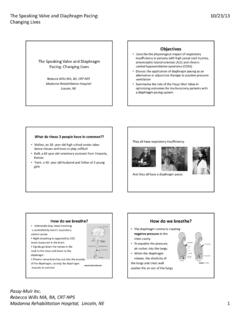Transcription of Helping the Chronically Critically Ill To Communicate ...
1 American Journal of Respiratory Critical Care Medicine 179;2009:A3083 Passy-MuirInc. Helping the Chronically Critically Ill To Communicate : Speaking Valve Pilot Trial A. Desai, MD1, L. Rho, MD1and J. Nelson, MD, JD1 Mt Sinai School of Med, NY, NY. Rationale: Prolonged mechanical ventilation (MV) is a hallmark of chronic critical illness (CCI) and a major source of distress for patients, who struggle to Communicate even after tracheotomy. In this pilot study, we evaluated the use of a Passy Muir (PM) speaking valve to assist communication by CCI patients during weaning from the ventilator. Methods: We studied consecutive, consenting, ventilator dependent, tracheotomized patients admitted from adult ICUs to our Respiratory Care Unit (RCU) for protocol based weaning.
2 Participation required ability to respond to English language evaluative tools, tolerance of cuff deflation, no vocal cord dysfunction, and expected RCU stay 10 days. The PM valve was placed for up to 60 minutes, as tolerated. Before and after valve placement, research staff recorded physiologic parameters (blood pressure, pulse, respiratory rate, SaO2), and patients rated communication (none to maximum ability) and dyspnea (none to maximum shortness of breath) on 0 10 scales. Results: We enrolled 10 of 13 (77%) eligible patients (5 men; mean SD age = 68 yrs; MV duration = days). The 60 minute trial was completed by 5 patients without subjective or objective distress. PM valve removal was requested by 5 patients at a median of 2 minutes (range 1 30) after placement due to dyspnea.
3 Staff noted accessory muscle use in 3 of these 5, but none had any physiologic deterioration. Mean communication ratings improved from to with valve use. Patients who tolerated the 60 minute trial reported better communication and less dyspnea than those who did not (communication, 10 0 vs. ; dyspnea, vs. ). Conclusions: The PM speaking valve is tolerated by some CCI patients and may facilitate communication as perceived by patients and caregivers during weaning from MV. In a larger sample, factors predicting tolerance and effectiveness of the valve in enabling communication may be identified. Crit Care Nurse. 2011 Jun;31(3):46-60 Passy-MuirInc. Promoting effective communication for patients receiving mechanical Ventilation Grossbach I, Stranberg S, Chlan L.
4 School of Nursing at the University of Minnesota, Minneapolis, MN 55408, USA. Abstract: Communicating effectively with ventilator-dependent patients is essential so that various basic physiological and psychological needs can be conveyed and decisions, wishes, and desires about the plan of care and end-of-life decision making can be expressed. Numerous methods can be used to Communicate , including gestures, head nods, mouthing of words, writing, use of letter/picture boards and common words or phrases tailored to meet individualized patients' needs. High-tech alternative communication devices are available for more complex cases. Various options for patients with a tracheostomy tube include partial or total cuff deflation and use of a speaking valve.
5 It is important for nurses to assess communication needs; identify appropriate alternative communication strategies; create a customized care plan with the patient, the patient's family, and other team members; ensure that the care plan is visible and accessible to all staff interacting with the patient; and continue to collaborate with colleagues from all disciplines to promote effective communication with nonvocal patients. Critical Care Medicine 1993 Apr;21(4):512-7. Passy-MuirInc. Verbal communication of ventilator-dependent patients Manzano JL, Lubillo S, Henr quez D, Mart n JC, P rez MC, Wilson DJ. Hospital Nuestra Se ora del Pino, Las Palmas de Gran Canaria, Canary Islands, Spain. OBJECTIVE: To assess whether communication capabilities of ventilator-dependent patients are improved by the use of the Passy-Muir unidirectional valve.
6 DESIGN: Prospective study. SETTING: An 18-bed multidisciplinary intensive care unit (ICU) at the University Hospital, Las Palmas, Spain. PATIENTS: Ten chronic ventilator-dependent patients who had undergone tracheostomy and met the following criteria: ability to eliminate tracheobronchial secretions in order to maintain a patent and unobstructed airway, adequate gas exchange while ventilated with an FIO2 of < or = (Pao2 > 60 torr [8 kPa]), Paco2 of < 55 torr ( kPa), normal hemodynamics without the need for administration of vasopressors, and normal mental state. Eight patients presented with pulmonary disease, and two presented with neuromuscular disease. INTERVENTIONS AND METHODS: Before attaching the Passy-Muir valve, the following procedures were performed: a) suction of tracheal and pharyngeal secretions; b) deflation of the tracheostomy tube cuff; c) increase in the ventilator's tidal volume setting to maintain the inspiratory pressure before cuff's deflation; d) set peak inspiratory pressure alarm and disconnect expiratory volume alarm.
7 The valve was then connected between the tracheostomy tube and the Y-shaped piece of the ventilator's circuit. Respiratory movements, arterial blood gases, peak inspiratory pressure, respiratory rate, quantity of secretions, and changes in sense of smell were monitored during the study. The valve's efficacy was evaluated according to the patient's ability to talk and be understood during the entire respiratory cycle. RESULTS: The Passy-Muir valve was effective in improving communication in eight of ten patients who, during its use, presented insignificant cardiorespiratory changes, decreased secretions, and effected considerable improvement in well-being. Its use was impossible in two patients: one with severe pulmonary disease because cuff deflation prevented adequate ventilation, and one patient with neuromuscular disease and laryngopharyngeal dysfunction.
8 Critical Care Medicine 1993 Apr;21(4):512-7. Passy-MuirInc. CONCLUSIONS: The Passy-Muir unidirectional valve allows ventilator-dependent patients to talk and Communicate without assistance. Patients felt better and were motivated to participate in their own care. Critical Care Nurse. 1996 Feb;16(1):63-8. Passy-MuirInc. Use of Passy-Muir tracheostomy speaking valve in mechanically ventilated neurological patients Bell SD. Abstract: Expressing one s wishes and desires is an integral part of daily life. Neurological diseases and injuries can rob a person of the normal ways to Communicate . Without the power to share knowledge, thoughts, ideas ,and feelings, people can become isolated. Being unable to Communicate deprives a conscious person on a ventilator of meaningful participation in the healthcare plan.
9 This article describes the use of a Passy-Muir Tracheostomy Speaking Valve in a ventilated patient with multiple sclerosis. Respiratory Care. 2005 Apr;50(4):519-25. Passy-MuirInc. Facilitating speech in the patient with a tracheostomy Hess DR. Department of Respiratory Care, Ellison 401, Massachusetts General Hospital, 55 Fruit Street, Boston MA 02114, USA. Abstract: A tracheostomy tube decreases the ability of the patient to Communicate effectively. The ability to speak provides an important improvement in the quality of life for a patient with a tracheostomy. In mechanically ventilated patients, speech can be provided by the use of a talking tracheostomy tube, using a cuff-down technique with a speaking valve, and using a cuff-down technique without a speaking valve.
10 Speech can be facilitated in patients with a tracheostomy tube who are breathing spontaneously by use of a talking tracheostomy tube, by using a cuff-down technique with finger occlusion of the proximal tracheostomy tube, and with the use of a cuff-down technique with a speaking valve. Teamwork between the patient and the patient care team (respiratory therapist, speech-language pathologist, nurse, and physician) can result in effective restoration of speech in many patients with a long-term tracheostomy. Otolaryngology Head Neck Surgery. 1986 Sep;95(2):247-8. Passy-MuirInc. Passy-Muir tracheostomy speaking valve Passy V. Abstract: Communication for handicapped ventilator-dependent patients is a problem, not only for the patient but also for the healthcare personnel.
